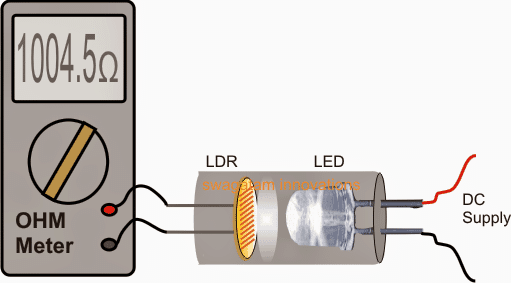In this post I will explain a simple LDR brightness and efficiency tester circuit set up using an LDR and a digital Ohm meter. The idea was requested by Mr. Prashant
Technical Specifications
I want to check brightness and light of 1 watt led.
Can i check it with help of ldr. Bekoz luminous sensor cost is too high.
How can i measure which led has bright light if i have three quality type 1 watt led.
Plz solve the prob.
Thank you
Prashant sharma
The Design
LEDs are not very complex light emitting devices when operated with DC supplies and the illumination level becomes directly proportional to the current across the LED.
Therefore reading the brightness level under the above condition may not require sophisticated circuitry as we have in lux meters, instead the reading can be simply obtained using an LDR and a cheap ohm meter.
The set up design of an LED brightness indicator may be witnessed below:
We see an LDR enclosed inside a hollow opaque tube. The LED whose brightness is required to be measured is inserted through the opposite hollow end of the tube such that both the devices are brought face to face inside the tube.
A translucent white material such a roughened acrylic piece could be introduced between the two device inside the pipe in order to make the LED light diffuse over the LDR and produce an uniform distribution of light instead of getting focused over a small inconsistent area of the LDR.
With a DC applied across the enclosed LED leads the shown set up would produce a direct reading in the ohm meter indicating the Ohms of the lowered LDR resistance. This value may be noted and compared by other LEDs or a standard good quality LED in hand for getting the required information regarding their brightness levels and efficiency.
Circuit Diagram

value of LDR for checking led brigntness ….and sir can we get the led wattage by calculating the number displayed in ohm meter is their any formula for that
you can use any standard LDR and calibrate the meter reading by illuminating the LDR with an LED whose values are known, and then by referring to this reading on the meter you can calibrate the full sale of the meter proportionately.
Hello sir ………what should be the value of LDR
Hello Basit, value of LDR for which circuit?